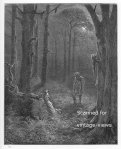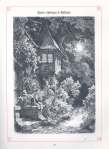
Strauss composed his Sechs Lieder Op.17 to poems by Adolf Friedrich von Schack between 1885 and 1887. At that time Strauss was the court music director in Meiningen and moved to Munich to become the Court Opera’s third conductor. Strauss’ early experience in the opera house not only stood him in good stead as an opera composer, but his songs often have an operatic sweep about them, and a clear sense of climax and dramatic pacing.
Strauss’ music brings to life the expectation and excitement of the clandestine tryst of Schack’s poem.
Ständchen by Adolf Friedrich, Graf von Schack (1855-1894)
Mach auf, mach auf, doch leise mein Kind,
Um keinen vom Schlummer zu wecken.
Kaum murmelt der Bach, kaum zittert im Wind
Ein Blatt an den Büschen und Hecken.
Drum leise, mein Mädchen, daß [nichts sich]1 regt,
Nur leise die Hand auf die Klinke gelegt.
Mit Tritten, wie Tritte der Elfen so sacht,
[Die über die Blumen]2 hüpfen,
Flieg leicht hinaus in die Mondscheinnacht,
[Zu]3 mir in den Garten zu schlüpfen.
Rings schlummern die Blüten am rieselnden Bach
Und duften im Schlaf, nur die Liebe ist wach.
Sitz nieder, hier dämmert’s geheimnisvoll
Unter den Lindenbäumen,
Die Nachtigall uns zu Häupten soll
Von unseren Küssen träumen,
Und die Rose, wenn sie am Morgen erwacht,
Hoch glühn von den Wonnenschauern der Nacht..
Ständchen in free translation by Albert Combrink
“Love Song”
Open up, open up, but softly my child,
So as not to wake anyone from their sleep,
The stream is barely murmuring, the wind hardly causes quivers
In a leaf on bush or hedge.
So, softly, my young girl, so that nothing stirs,
Just lay your hand softly on the door-latch.
With steps as soft as the footsteps of elves,
that hop over the flowers,
Fly lightly out into the moonlit night,
Sneak to me in the garden.
Around us sleeps the blossoms along the trickling stream,
Fragrant in sleep, only love is awake.
Sit down, here it darkens mysteriously
Beneath the linden trees,
The nightingale over our heads
Shall dream of our kisses,
And the rose, when it wakes in the morning,
Shall glow from the joyous showers of the night.

"Lovers in the garden" Paul Gustave Dore (1832-1883)
Early in his career Strauss was obviously taken with the poems of Von Schack – the son of a wealthy landowner – setting 16 of his poems in the songs which comprise his Opus 15, 17 and 19 sets, completed by the age of 24. As with most of Strauss’ choice of poets, Schack might not be regarded as a towering figure in the poetic landscape, so to speak. Yet his poems provide much suggestive imagery to stimulate the imagination – especially one as creative as Strauss. Schack’s moonlit forest shakes, trembles, quakes and quivers and in the morning the roses will be glowing form the night’s “Wonnenschauern” – a virtually untranslatable portmanteau suggesting the “joyous showers” of the night’s activities (perhaps one would be wise not to interpret it only literally). The grammar of the poem makes it hard to distinguish whether the poet is taking the beloved into the night, or merely singing a song of seduction and describing the delights that await them – as the title suggests. The music however, tells a fuller story.
Tonality is vitally important in the music of Strauss and he adhered loosely to a set of tonal symbols. C major is often regarded as his “Key of Creation”, of elemental power, the source of the Big Bang: note for example the opening of Also Sprach Zarathustra or the song Zueignung (Op. 10 No.1) – both powerful existential statements. A flat major is used for pious religious expressions such as those of John the Baptist in the opera Salome. Ständchen is in F Sharp major, a key it only shares with a single other song from his 205: Traum durch die Dämmerung. This is also the key of love at first sight in the “Presentation of the Rose” duet from Der Rosenkavalier. Often associated with love, dreaminess and intoxication, this key suggests two lovers “high” on love, the romance of the moment and the beauty of the surroundings.

The house near the forest - anon.
Musically the first two verses are repeated verbatim. Verse one lures the beloved out the door. Verse two lures the beloved into the darkness of the Linden trees. Octave leaps, like an ardent but secret call and long passages in the same key suggest so beautifully the furtive seduction. The piano quakes and quivers in excitement and but also surrounds the voice in the night-sounds of the forest: the trembling, rustling and positively quaking leaves and the murmuring trickle of the ever-flowing but never dangerous stream. The excited frisson in the hearts of the lovers is expressed in the darting of the piano part. The figuration is more pianistic than it appears at first sight: The 4th finger falls naturally on the black notes and the short 5th finger feels comfortably in place on the adjacent white finger, making the rippling pianissimo a joy to play. Yet some sharp-shooters’ aim is required when the modulations move in between the black notes.
Verse three gets down to the serious business of love-making. As the beloved is invited to “sink down” on the soft grass, the piano part sinks gently down to the key of D Major, the key of nature: Daphne in the garden; the garden of the “Vier Letzte Lieder. The flattened VI key is such a quintessentially Romantic musical symbol for the mysterious and the magical. Another magical use of the flattened sixth key occurs in Schubert’s rapturous Nacht und Träume (Night and Dreams, D. 827) of 1822, where the joy of the dreamers is expressed with breathtaking tenderness.
The piano part of the third verse reveals some fussiness on the part of the composer. The little figurations, while remaining true to the original idea, change shape and inversions a few too many times, making it unnecessarily awkward for the pianist. I wonder if some have not cheated the odd beat or two. It is mainly pianissimo and the pedal hides a multitude of sins. As the piano part modulates downwards to B Major, the voice starts its ecstatic ascent to the climax, Strauss finding it necessary to repeat the words “Hoch glühn” (glowing on high) to sustain the excitement and extend the exquisite consummation.

Linden Tress abound in German Lieder
At this point there is a discrepancy between the piano-accompanied version of the song, and the orchestral arrangement of the song. In the orchestral version the high A sharp of the climax is held double the length. It is a glorious effect. I have heard various sopranos take the “long cut” in the piano version, with the pianist either left high and dry at the barline, or, in the case of some conductor-pianists such as Wolfgang Swallisch and Sir Georg Solti, they reversed the process of orchestration and rewrote the piano part, adding extra bars as per the orchestral version. The orchestral version also ends more abruptly, leaving out the piano’s brief but charming postlude.
Strauss only wrote 15 of his 205 songs expressly for Voice and Orchestra. He himself orchestrated 25 of the piano accompaniments and sanctioned some by others. These orchestrations were done at various times in his career, often to provide concert material for his wife Pauline de Ahna and some of the various sopranos with whom he travelled after Pauline’s career started winding down, such as the creator of the title role in Arabella, Viorica Ursuleac whom Strauss called “die treueste aller Treuen” (“the most faithful of all the faithful”).
Some recordings:
Walter Gieseking made a beautiful transcription of the song for solo piano. His own performance is unhurried and tender, a beautiful version giving a distilled ‘gestalt’, when the visceral excitement generated by a voice, is absent. FREE SHEET MUSIC of Gieseking’s transcription of Ständchen is available.
An opera singer more famous for his Puccini than his Strauss, Jussi Björling’s Bel Canto brings a wonderful line to this song, in an orchestral version.
Lotte Lehman (recorded here in 1941) remains an authority in this repertoire, having performed many times with Strauss himself.
Dietrich Fischer-Dieskau, the Über-Guru of Lieder, performs here with his main collaborator in the autumn-years of his career – Hartmut Höll, piano. This is about as deffinitive as modern interpretations get.
Fritz Wunderlich, who performed so many of Strauss’ taxing tenor roles before his untimely death, here gives one of the performances of a lifetime, in an orchestral set of Strauss comprising: 1 Heimliche Auffforderung, 2 Ständchen and 3 Zueignung.
Nicolai Gedda perhaps does not strike one immediately as primarily a lieder singer, but much of career was built around recital repertoire. Hs version is beautifully youthful and tender.
Sir Georg Solti postively basks in the virtuosity of the piano part. Here he acompanies Kiri te Kanawa with whom he performed and recorded not only the piano and orchestral version of this song, but also recorded a glorious Vier Letzte Lieder.
While the sheer sweep and drama of many of Strauss’ songs have attracted many larger voices, two very different versions by two very different sopranos reveal how the material can translate well to either voice-type in the hands of an intelligent singer. The Wagnerian size of Birtgit Nilsson (accompanied by Janos Solyom – 1975) contrasts sharply with the lyric colloratura of Kathleen Battle (accompanied by Warren Jones – 1991) but both reveal different aspects of the beauty of this song.
Renée Fleming and the Lucerne Festival Orchestra conducted by Claudio Abbado perform an unidentified orchstration in 2005.
A young Kiri te Kanawa and Richard Amner perform a radiant version at the Royal Opera House, Covent Garden in 1978.
Related Material: Nacht und Träume by Franz Schubert, performed here by the two High Priests of Lieder, Dietrich Fischer-Dieskau (baritone) and Gerald Moore (piano)
Unlike the Linden Tree, the “Tree of Lovers” in German literature, Ständchen is evergreen and beloved the world over.


I’ve sung this song – really beautiful. Thanx for the info.
Hello,
This is an excellent analysis of this charming Lied. I wonder what you think of Irmgard Seefried’s rendition, both with orchestra (Piero Bellugi) and with piano (Erik Werba). Isn’t there something so fresh and unaffected about her style?